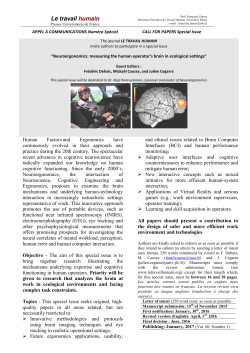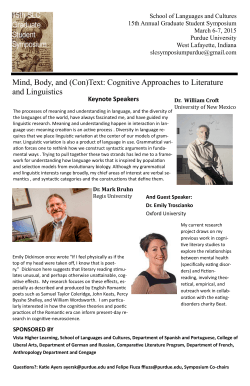
cognitive interventions for the client with mild neurocognitive disorder
COGNITIVE INTERVENTIONS FOR THE CLIENT WITH MILD NEUROCOGNITIVE DISORDER (MNCD) (PREVIOUSLY CALLED MILD COGNITIVE IMPAIRMENT) OVERVIEW AND UPDATE AOTA Conference Nashville TN, April 18, 2015 Arlene Lorch, OTD, OTR/L, CHES Tracey Vause Earland, MS, OTR/L Department of Occupational Therapy, Jefferson School of Health Professions Thomas Jefferson University SUMMARY Occupational therapists serve individuals in need of care for cognitive issues that go beyond normal aging changes. The primary concerns facing these individuals are problems with attention, memory and aspects of executive functioning, as they relate to, and impact, occupational participation and functioning. Recent studies suggest that identifying mild neurocognitive disorder as early as possible may allow interventions to be more effective (DSM, 2013). Based upon the theory of cognitive reserve and established concepts of neural plasticity, there is mounting evidence to suggest that therapies can moderate the effects of MNCD. Before intervention, evaluation and assessment are essential and should include interview, skilled observation, family or CG perspective if relevant, mental status screens such as St. Louis University Mental Status (SLUMS) and performance based assessments such as the Cognitive Performance Test (CPT). Basic approaches include cognitive stimulation therapy, cognitive training and cognitive rehabilitation. Cognitive Stimulation For people with mild to moderate neurocognitive disorder – usually delivered by specially trained professionals such as occupational therapists. Can be conducted individually or more commonly in small groups. Offers a range of enjoyable or meaningful activities providing general stimulation for thinking, concentration memory and social functioning. It incorporates the use of activity analysis and the grading of activities to best meet the needs of the client (Salmon, 2006). Interventions: leisure activities within a social setting with a cognitive component (social setting can be in a group or 1:1 and should occur repeatedly over weeks) o Sensory stimulating activities (e.g. music) o Reminiscence o Money management activities o Number related activities o Word related activities o Quizzes and trivia games o Physical and cognitive games o Music-related activities o Current affairs discussion Cognitive Training – Two types Restorative cognitive training aims to enhance cognitive abilities though neuroplastic mechanisms. Structured and repeated practice of specific cognitive tasks and mental exercises may improve abilities in specific cognitive domains (Huckens et al., 2013). Compensatory cognitive training can include internal strategies such as using visual imagery, chunking, or acronyms to compensate for memory difficulties, through the use of structure problem-solving and planning methods (Huckens et al., 2013). Structured practice on tasks relevant to aspects of cognitive functioning, such as attention/memory, language or executive function (Marten et al., 2011). Delivery methods: 1:1 or in a group Therapeutic tools (example, mental memory strategies) and tasks may be presented in various modalities paper/pencil, computer, visual and auditory attention activities, memory activities related to daily occupations using visual aids (Brum et al., 2009) Cognitive Rehabilitation is systematic behavioral therapy specifically designed to improve cognitive performance, help individuals to compensate for impaired cognitive performance, or enable individuals to adapt to impaired cognitive performance (Huckens et al., 2013). Cognitive rehabilitation is a multidisciplinary field that identifies and addresses individual needs & goals, which require strategies for taking in new information or compensatory methods such as use of memory aids (Claire, Woods, 2010). It is a multifaceted, re-educational, retraining, and adaptive process involving the person with mild NCD, caregivers, and the environment. Maximizes daily function and participation addressing habits & routines and contextual factors Incorporates many aspects of cognitive interventions in context! Focus of intervention: Make the most of residual memory ability (e.g. help patients develop strategies for learning information using less impaired component of the memory system) Develop compensatory strategies to minimize cognitive demands of activities Delivery method: Primarily 1:1 (vs. group); Tends to be implemented in real-world settings Intervention goals are selected collaboratively A combination of restorative and compensatory approaches combined with psycho-education and strategy training. o Skill-Task Habit Training o Errorless learning o Procedural learning o Spaced and Expanding Retrieval Techniques o Strategy Training o Task-Environment Modifications Training (Radomski, et al, 2014) Many cognitive intervention programs combine some aspects of training, stimulation, and/or rehabilitation. We believe that appropriate application of these interventions may improve cognitive functioning for occupational engagement, sense of self-efficacy and quality of life. REFERENCES American Occupational Therapy Association. (2012).Cognition, Cognitive Rehabilitation and Occupational Performance Official Statement retrieved 9/8/14 from http://www.aota.org//media/Corporate/Files/AboutAOTA/OfficialDocs/Statements/Cognition%20Cognitive%20 Rehabilitation%20and%20Occupational%20Performance.pdf. American Occupational Therapy Association. (2014). Occupational therapy practice framework: Domain and Process (3rd Ed.) American Journal of Occupational Therapy, 68 (Suppl.1). http://dx.doi.org/105014/ajot.2014.682006. American Psychiatric Association (2013). Diagnostic and Statistical Manual of Mental Disorders 5th ed. American Psychiatric Publishing: Washington DC. Bahar-Fuchs A, Clare L, Woods B. (2013). Cognitive training and cognitive rehabilitation for mild to moderate Alzheimer’s disease and vascular dementia. Cochrane Database of Systematic Reviews, Issue 6. Art. No.: CD003260. DOI: 10.1002/14651858.CD003260.pub2. Brum, P.S., Forlenza, O.V., Yassuda, M.S. (2009). Cognitive training in older adults with mild cognitive impairment: Impact on cognitive and functional performance. Dementia and Neuropsychologia, 3(2):124-131. Clare, L., Linden, D. E., Woods, R. T., Whitaker, R., Evans, S. J., Parkinson, C. H. & Rugg, M. D. (2010). Goaloriented cognitive rehabilitation for people with early-stage Alzheimer disease: a single-blind randomized controlled trial of clinical efficacy. The American journal of geriatric psychiatry, 18(10), 928-939. Corcoran, M.A. & Giles, G. M., (Eds) (2014).Neurocognitive Disorder (NCD): Interventions to Support Occupational Performance, Neurorehabilitation in Occupational Therapy Series, Vol. 1. Bethesda, MD: AOTA Press. Forster S. Buschert VC. Teipel SJ. Friese U. Buchholz HG. Drzezga A. Hampel H. Bartenstein P. Buerger K. (2011). Effects of a 6-month cognitive intervention on brain metabolism in patients with amnestic MCI and mild Alzheimer's disease. Journal of Alzheimer's Disease. 26 Suppl 3:337-48, 2011. Gitlin L.N, Vause-Earland, T. (2008). Improving Quality of Life in Individuals with Dementia: The Role of Nonpharmacologic Approaches In Rehabilitation. In: JH Stone, M Blouin (Editors). International Encyclopedia of Rehabilitation. Available online http://cirrie.buffalo.edu/encyclopedia/index.php?language=en Gitlin, L. N., Winter, L., Dennis, M. P., Hodgson, N., & Hauck, W. W. (2010). A biobehavioral home-based intervention and the well-being of patients with dementia and their caregivers: the COPE randomized trial. Jama, 304(9), 983-991. Healey, WE (2012). Mild Cognitive Impairment. Topics in Geriatric Rehabilitation • Volume 28, Number 3, 157– 162 • Wolters Kluwer Health | Lippincott Williams & Wilkins DOI: 10.1097/TGR.0b013e31825d377e Huckans, M., Hutson, L., Twamley, E., Jak, A., Kaye, J., & Storzbach, D. (2013). Efficacy of cognitive rehabilitation therapies for mild cognitive impairment (MCI) in older adults: Working toward a theoretical model and evidence-based interventions. Neuropsychology Review, 23(1), 63-80. doi:10.1007/s11065-013-9230-9 [doi] Kinsella, GJ, Mullaly, E., Rand, E., Ong, B., Burton, C., Price, S, Phillips, M, & Storey, E. (2009). Early intervention for mild cognitive impairment: a randomized controlled trial. Neurol Neurosurg Psychiatry 80: 730-736.doi: 10.1136/jnnp.2008.148346 Moro, V, Condoleo, MT, Sala, F, Pernigo, S, Moretto, G and Gambina, G. (2012). Cognitive Stimulation in a-MCI: An Experimental Study. Am J Alzheimers Dis Other Demen 27:121. DOI: 10.1177/1533317512441386 Orrell, M., Woods, B & Spector, A.(2012) Should we use individual cognitive stimulation therapy to improve cognitive function in people with dementia? BMJ 344-356. Petersen RC, Doody R, Kurz A, et al. (2001). Current concepts in mild cognitive impairment. Arch Neurol; 58:1985-1992.10. Petersen RC.(2011). Mild cognitive impairment. N Engl J Med.; 364: 2227- 2234. th Radomski, M. V., & Latham, C. A. T. (2014). Occupational therapy for physical dysfunction, 7 Ed. Philadelphia: Lippincott Williams & Wilkins. Rebok, G. W., Ball, K., Guey, L. T., Jones, R. N., Kim, H., King, J. W., et al. (2014). Ten-year effects of the advanced cognitive training for independent and vital elderly cognitive training trial on cognition and everyday functioning in older adults. Journal of the American Geriatrics Society, 62(1), 16-24. doi:10.1111/jgs.12607. Robnett, R, & Toglia, J. (2015). Evidence-Based interventions for older adults with mild cognitive impairment. OT Practice (20)1, CE1-CE8. Reichman, WE, Fiocco, AJ, Rose, NS Exercising the Brain to Avoid Cognitive Decline Examining the Evidence Aging Health. 2010;6(5):565-584. Retrieved Sept 14, 2014 http://www.medscape.com/viewarticle/740651_11. Robert, A., Gélinas, I., & Mazer, B. (2010). Occupational therapists use of cognitive interventions for clients with alzheimer's disease. Occupational Therapy International, 17(1), 10-19. doi:10.1002/oti.283.\ Robnett, R, & Toglia, J. (2015). Evidence-Based interventions for older adults with mild cognitive impairment. OT Practice (20)1, Continuing Education Article, CE1-CE8 Rojas GJ. Villar V. Iturry M. Harris P. Serrano CM. Herrera JA. Allegri RF. (2013). Efficacy of a cognitive intervention program in patients with mild cognitive impairment. International Psychogeriatrics. 25(5):825-31. Rosen AC. Sugiura L. Kramer JH. Whitfield-Gabrieli S. Gabrieli JD. (2011). Cognitive training changes hippocampal function in mild cognitive impairment: a pilot study. Journal of Alzheimer's Disease. 26 Suppl 3:349-57. Salmon, N. (2006). Cognitive stimulation therapy versus acetyl cholinesterase inhibitors for mild to moderate dementia: A latter-day david and goliath? British Journal of Occupational Therapy, 69(11), 528-530. Retrieved from http%3a%2f%2fsearch.ebscohost.com%2flogin.aspx%3fdirect%3dtrue%26db%3dcin20%26AN%3d2009482082% 26site%3dehost-live%26scope%3dsite Stern Y (2002). What is cognitive reserve? theory and research application of the reserve concept. J Int Neuropsychol Soc.8:448-460. ___________________________________________________________________________________________ SAMPLE COGNITIVE TRAINING (MEMORY) INTERVENTIONS 1. Recall of events since last session (using backtracking method) 2. Review use of memory strategies during the week. Which worked, which didn’t work? How often used? 3. Review “assignments”: Learning names of two people at group meeting and completing one cognitive activity per day in “Use it or Lose it” book” (Attainment) 4. Select and practice one strategy to remember errands list. 5. Focusing attention, short term memory activities using information inserts from medicines 6. Use mental strategies for remembering ingredients and steps of the recipe she will cook for dinner. __________________________________________________________________________________________________ “REMEMBERING ERRANDS” ACTIVITY Emily identifies four errands she has to do tomorrow. 1. 2. 3. 4. Go to the pharmacist to get medications refilled. Go to the food store to pick up milk and bread. Go to the dry cleaners to pick up winter coat. Go to the card store to buy a birthday card for daughter. Emily is taught one or two memory strategies and practices using them to remember the list. REHEARSAL Repeating information to yourself either mentally or verbally such as key words, rules, action steps or facts to help you retain information. Also, mentally practice of procedures or performance of a task. MNEMONIC TECHNIQUES Form associations between words, sets of words, pictures or images to cue your actions or recall. ASSOCIATION Link similar information together based on previous experiences, similar categories or physical similarities RECONSTRUCTION Think back and replay, imagine, or talk about a previous activity, experience or setting to help in guiding you to act in a new situation ANTICIPATION Imagine or verbalize out loud potential challenges or obstacles that could occur in a situation to help in preparing for a task, such as before going to a new place. SELF-GUIDANCE Give yourself directions or remind yourself of what you already know about a task to prepare oneself through a task. Give yourself positive self-talk and encouragement to increase your persistence through a task or situation, (for instance, “Emily, you can do this, stay calm”).
© Copyright 2025









